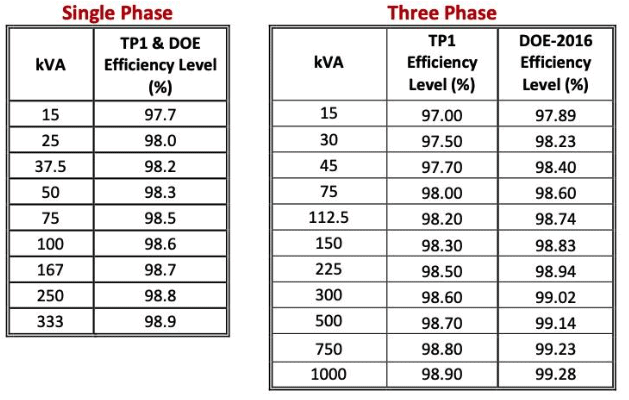DOE 2016, or the Department of Energy’s 2016 efficiency standards, is crucial for transformers due to its environmental and economic benefits. These standards mandate higher energy efficiency levels, reducing energy losses during power transmission. This regulation also translates to long-term cost savings for companies, consumers and utilities as efficient transformers require less maintenance and have lower operational expenses. Overall, DOE 2016 is essential for a greener, more efficient electrical grid and a sustainable energy future.
The previous TP1 standard is no longer valid and has been replaced with DOE 2016. This Energy Act mandates specific types of low voltage dry-type transformers manufactured and sold in the USA to have efficiencies as defined by the 10 CFR Part 431 Standard when loaded to 35% of maximum capacity.
DOE 2016 covers low-voltage dry-type distribution transformers as defined by:
- Input voltage of 34.5 kilovolts or less
- Output voltage of 600 volts or less
- Rated for operation at a frequency of 60 Hertz
- Rated capacity of 15 kVA to 1000 kVA
- Air-cooled
These transformers must meet the 10 CFR Part 431 Efficiency levels with a 35% load and a temperature of 75 degrees Centigrade. Efficiencies are determined at the following reference conditions: (1) For no-load losses, at the temperature of 20°C, and (2) For load losses, at the temperature of 75°C and 35 percent of nameplate load.
Transformers that are not covered by the DOE 2016 efficiency standard:
- Autotransformers
- Drive (isolation) transformers
- Neutral Grounding transformers
- Machine-tool control transformers
- Non-ventilated transformers (TENV)
- Rectifier transformers
- Regulating transformers
- Sealed transformers
- Special-impedance transformers
- Testing transformers
- Transformers with tap range of 20 percent or more
- Uninterruptible power supply transformers
- Welding transformers
- Surface and above ground mining transformers
- Transformers with multiple primary windings
AFP can help you decide if your application requires the DOE 2016 efficiency standard and if required has the design experience to provide you with the most cost effective solution.
